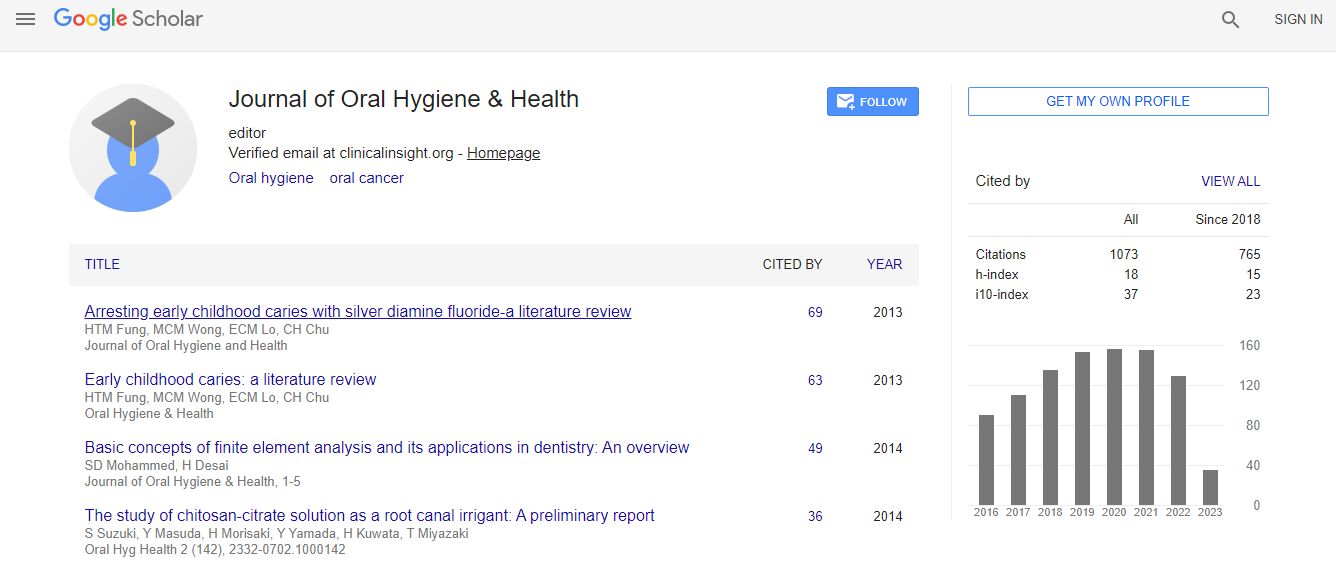Our Group organises 3000+ Global Conferenceseries Events every year across USA, Europe & Asia with support from 1000 more scientific Societies and Publishes 700+ Open Access Journals which contains over 50000 eminent personalities, reputed scientists as editorial board members.
Open Access Journals gaining more Readers and Citations
700 Journals and 15,000,000 Readers Each Journal is getting 25,000+ Readers
Google Scholar citation report
Citations : 1073
Journal of Oral Hygiene & Health received 1073 citations as per Google Scholar report
Journal of Oral Hygiene & Health peer review process verified at publons
Indexed In
- Index Copernicus
- Google Scholar
- Open J Gate
- JournalTOCs
- RefSeek
- Hamdard University
- EBSCO A-Z
- OCLC- WorldCat
- Publons
- Geneva Foundation for Medical Education and Research
- Euro Pub
- ICMJE
Useful Links
Recommended Journals
Related Subjects
Share This Page
Comparison of dimensional accuracy of conventionally and digitally manufactured intra-coronal restorations
2nd International Conference on Restorative Dentistry and Prosthodontics
Leila Nasiry Khanlar and Reza Eftekhar Ashtiani
Shahid Beheshti University of Medical Sciences, Iran
Posters & Accepted Abstracts: J Oral Hyg Health
Abstract
Purpose: This study sought to compare the dimensional accuracy of intra-coronal restorations fabricated using digital and conventional techniques. Materials & Methods: A sound mandibular molar tooth received standard onlay preparation. In group A, the onlays were made after conventional impression and conventional fabrication of resin pattern. In group E, the onlays were made after conventional impression and 3D printing of pattern. In group O, the onlays were made after intraoral scanning by Trios (3 Shape) and the resin pattern was produced by 3D printing. Ten specimens were in each group and totally 30 specimens were evaluated. Glass ceramic restorations (e.max Press, Ivoclar) were fabricated using the press technique. The replica technique was used to assess the marginal fit. Each replica was assessed in eight points. One-way ANOVA was used to compare the marginal gap among the three groups. Tukey�s HSD test was applied for pairwise comparisons of the groups. P�0.05 was considered statistically significant. Results: No significant difference was noted in the marginal gap at the gingival margin among the three groups (P=0.342), but significant differences were noted among the three groups in the pulpal (P=0.025) and buccal (P=0.0031) areas. Comparison of the absolute gap among the three groups revealed that only groups A and E were significantly different (P=0.020). Conclusions: Within the limitations of this study, it appears that restorations fabricated with the three techniques have dimensional accuracy within the clinically acceptable range. However, the conventional method yielded more accurate results.Biography
Email: lana1354@yahoo.com

 Spanish
Spanish  Chinese
Chinese  Russian
Russian  German
German  French
French  Japanese
Japanese  Portuguese
Portuguese  Hindi
Hindi 
